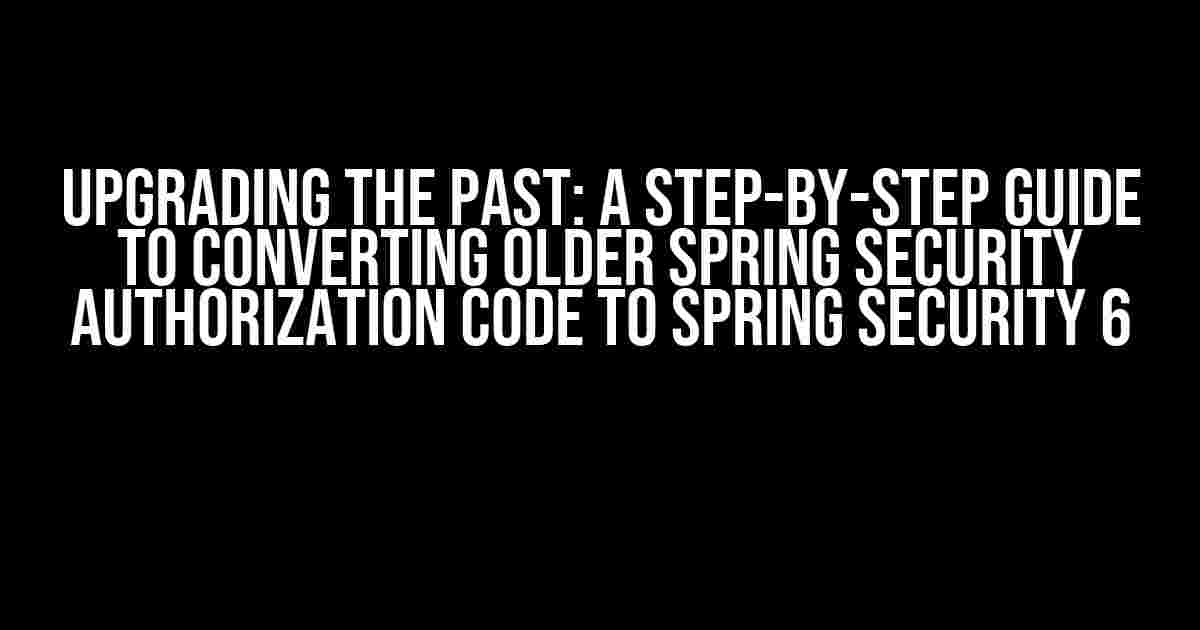Are you tired of living in the past with your outdated Spring Security authorization code? Do you dream of embracing the latest and greatest features of Spring Security 6? Look no further! This comprehensive guide will walk you through the process of converting your older code to the latest and greatest, ensuring you’re up-to-speed with the most secure and efficient authorization system.
- Before We Begin: Understanding the Changes in Spring Security 6
- Step 1: Upgrade Your Dependencies
- Step 2: Migrate Your Configuration
- Step 3: Update Your AuthenticationManager
- Step 4: Implement Custom Authentication Providers
- Step 5: Update Your Security Annotations
- Step 6: Migrate Your Web Security Configuration
- Step 7: Test and Refine
- Conclusion
Before We Begin: Understanding the Changes in Spring Security 6
Before diving into the conversion process, it’s essential to understand the significant changes introduced in Spring Security 6. Here are some key takeaways:
- Simplified Configuration: Spring Security 6 introduces a more straightforward and intuitive configuration model, eliminating the need for complex XML files and annotations.
- Improved Security: The latest version comes with enhanced security features, such as improved password hashing and password-based key derivation functions.
- New Architecture: Spring Security 6 adopts a modular architecture, making it easier to maintain and extend.
Step 1: Upgrade Your Dependencies
The first step is to upgrade your Spring Security dependencies to the latest version. Update your `pom.xml` file (if you’re using Maven) or your `build.gradle` file (if you’re using Gradle) to include the following dependencies:
<dependency> <groupId>org.springframework.security</groupId> <artifactId>spring-security-core</artifactId> <version>6.0.0</version> </dependency> <dependency> <groupId>org.springframework.security</groupId> <artifactId>spring-security-web</artifactId> <version>6.0.0</version> </dependency> <dependency> <groupId>org.springframework.security</groupId> <artifactId>spring-security-config</artifactId> <version>6.0.0</version> </dependency>
Step 2: Migrate Your Configuration
In Spring Security 6, the configuration is significantly simplified. Gone are the days of complex XML files and annotations! Instead, you’ll use a straightforward Java-based configuration.
@Configuration
@EnableWebSecurity
public class SecurityConfig extends WebSecurityConfigurerAdapter {
@Bean
public UserDetailsService userDetailsService() {
return new CustomUserDetailsService();
}
@Override
protected void configure(HttpSecurity http) throws Exception {
http.authorizeRequests()
.antMatchers("/admin/**").hasRole("ADMIN")
.anyRequest().authenticated()
.and()
.formLogin();
}
}
Step 3: Update Your AuthenticationManager
In Spring Security 6, the `AuthenticationManager` is now an interface, and you’ll need to provide an implementation. You can use the `ProviderManager` as a default implementation:
@Bean
public AuthenticationManager authenticationManager(AuthenticationConfiguration configuration) {
return new ProviderManager(new CustomAuthenticationProvider());
}
Step 4: Implement Custom Authentication Providers
If you have custom authentication providers, you’ll need to update them to conform to the new `AuthenticationProvider` interface:
public class CustomAuthenticationProvider implements AuthenticationProvider {
@Override
public Authentication authenticate(Authentication authentication) throws AuthenticationException {
// Your custom authentication logic here
return new UsernamePasswordAuthenticationToken("username", "password");
}
@Override
public boolean supports(Class authentication) {
return true;
}
}
Step 5: Update Your Security Annotations
Spring Security 6 introduces new annotations for method-level security. Update your code to use the new annotations:
@Service
public class MyService {
@Secured("ROLE_ADMIN")
public void adminOnlyMethod() {
// Admin-only logic here
}
}
Step 6: Migrate Your Web Security Configuration
In Spring Security 6, the web security configuration is simplified and more flexible. Update your code to use the new `http` builder:
@Override
protected void configure(HttpSecurity http) throws Exception {
http.authorizeRequests()
.antMatchers("/admin/**").hasRole("ADMIN")
.anyRequest().authenticated()
.and()
.formLogin()
.and()
.httpBasic();
}
Step 7: Test and Refine
Test your application thoroughly to ensure the conversion was successful. Refine your configuration as needed to achieve the desired security posture.
| Old Configuration | New Configuration |
|---|---|
| `security:authorize-requests` | `http.authorizeRequests()` |
| `security:form-login` | `http.formLogin()` |
| `security:http-basic` | `http.httpBasic()` |
Conclusion
Converting your older Spring Security authorization code to the latest Spring Security 6 is a significant undertaking, but with this step-by-step guide, you’re well on your way to a more secure and efficient authorization system. Remember to test thoroughly and refine your configuration as needed.
By following these instructions, you’ll be able to take advantage of the latest features and improvements in Spring Security 6. Happy coding!
If you have any questions or need further assistance, please don’t hesitate to ask. The Spring Security community is always here to help.
- Spring Security 6 Documentation: https://docs.spring.io/spring-security/reference/6.0.0/
- Spring Security 6 Migration Guide: https://docs.spring.io/spring-security/reference/6.0.0/migration/migrate-6.html
- Spring Security Community Forum: https://stackoverflow.com/questions/tagged/spring-security
Frequently Asked Question
Upgrading to the latest Spring Security 6 can be a daunting task, especially when it comes to converting older authorization code. Worry not, dear developer, for we’ve got you covered!
What are the main differences between older Spring Security and Spring Security 6?
Spring Security 6 introduces significant changes, including a revamped architecture, new dependencies, and enhanced security features. You’ll need to adapt to these changes when upgrading, such as moving from XML-based configurations to Java-based configurations, and utilizing the new `SecurityFilterChain` API.
How do I handle deprecated methods and classes in Spring Security 6?
When upgrading, you’ll encounter deprecated methods and classes. You can use the Spring Security migration guides, JavaDoc comments, and online resources to find the correct replacements. For example, the `WebSecurityConfigurerAdapter` is now deprecated, and you should use the `SecurityFilterChain` API instead.
What about authentication and authorization mechanisms in Spring Security 6?
Spring Security 6 introduces new authentication and authorization mechanisms, such as the `AuthenticationManager` and `AuthorizationManager` APIs. You’ll need to adapt your existing code to utilize these new APIs, which provide more flexibility and customization options.
Are there any tools or resources available to help with the migration process?
Yes, Spring provides an official migration guide, as well as various online resources and tutorials. Additionally, you can use IDE plugins, such as the Spring Tools, to help with the migration process. Don’t be afraid to reach out to the Spring community for support!
What’s the best approach to testing my migrated Spring Security 6 code?
To ensure your migrated code works as expected, write comprehensive tests using frameworks like JUnit and Testcontainers. Focus on testing the security configuration, authentication, and authorization mechanisms. You can also use tools like OAuth2 Toolkit to test OAuth2-related functionality.

